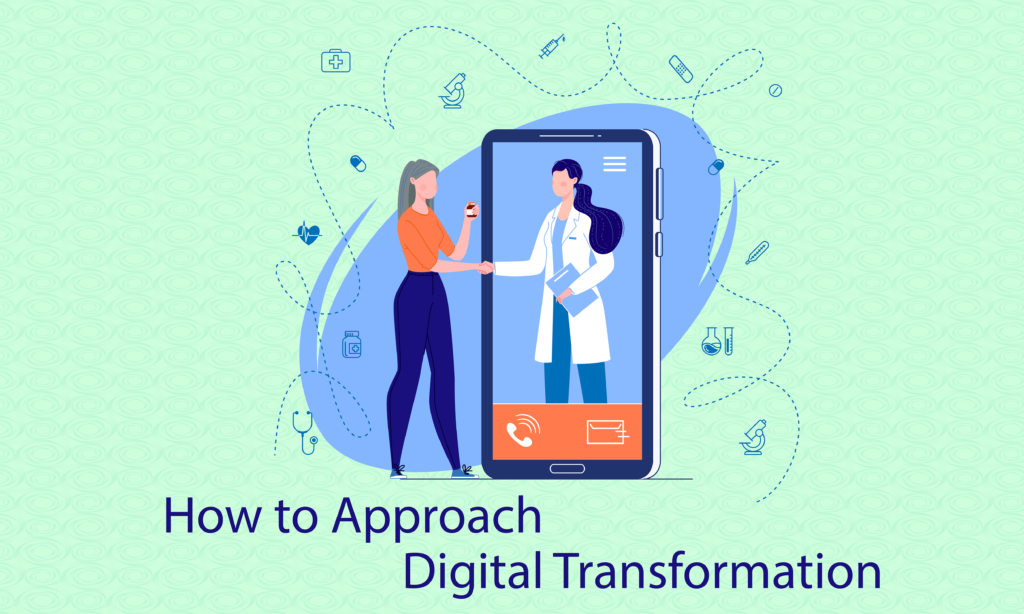The advent of the digital age has transformed many industries with healthcare being no exception, albeit uptake has been slow until COVID came. During the pandemic, the healthcare industry has witnessed firsthand how digital technology was able to deliver timely care wherever the patient may be, enhance patient health outcomes, and significantly reduce costs through its preventative element.
There is no question then that digital transformation provides an opportunity for healthcare organizations, particularly primary care physician practices to optimize their care delivery and grow their business. For many providers, tapping a new revenue stream is now the topmost priority, and adopting an innovative technology can be the means to achieve it.
So how should practices approach digital transformation to ensure growth?
Keeping up with the trends
Ever since the pandemic started, the healthcare industry has been trying to keep up with the trends as more providers and consumers are expecting more innovation that comes with digital transformation. Aside from improved access and care delivery, practices are driven by the need for profitable growth as many healthcare organizations including larger systems have reported losses during the first quarter of 2022. The after-effects of the outbreak have pushed up operating costs and growing demands for new services are pressuring organizations to make substantial capital investments in new technologies.
The road to innovation has not been easy, especially for small primary care physician practices which find it overwhelming to keep up with current trends in digital transformation. There are various emerging technologies in the market and choosing the most suitable one is critical so as not to cause any disruptions to existing workflows. There are certain risks and even possible losses involved in shifting to new processes, particularly when there is still attachment to outdated practices or reluctance among the team members.
But it is a transformation that is no longer a nice-to-have but a must-have for the healthcare industry to provide the best care to patients while reducing healthcare spending, particularly for the high-cost, high-risk patient population.
Digital healthcare is convenient without the hassle of commuting or waiting for appointments to start. Consumers now prefer their doctors have an online presence so they can access care at any time and place.
The technology is able to expand access to care in remote and underserved communities. It is also improving work efficiency and productivity in practices as well as addressing the many pain points of the staff who often find the paperwork to be burdensome.
Applying digital technology to drive growth
Digital technology has many applications primarily in automating processes to reduce paperwork and improve organizational efficiency. Other uses include on-demand virtual care solutions, patient portals, connected ambulances, telemedicine, and virtual visits.
Hence, digital transformation is an innovation that healthcare organizations cannot ignore if they want to provide targeted intervention in their care and capitalize on a new revenue stream.
How does digital technology drive growth?
- It captures long-term customer value. Consumers are now requiring seamless access to various care options to obtain the care they need without stepping out of their homes. Practices can utilize the insights from customer data platforms to have a better understanding of consumer preferences to ensure marketing strategies are personalized and effective.
- It opens new channels to promote products and services. The innovation market is facilitating new partnerships and enticing startups to contribute to a more efficient and automated healthcare ecosystem. Practices can capitalize on these partnerships that do not require a huge capital investment. Not only are providers providing better quality care, but also reducing costs for themselves and the patients alike with digital technology enabling targeted intervention.
- It offers new business models that are easily scalable. Digital healthcare provides personalized and meaningful patient-clinician interactions that positively impact health outcomes, which in turn, incentivize the provider.
One of the more promising solutions in the digital health space is chronic disease management. Medicare has introduced virtual care and billable services like Chronic Care Management (CCM) and Remote Patient Monitoring (RPM). Through the use of digital technologies, CCM can provide multiple touch points in-between office visits to ensure compliance to care instructions. RPM captures patient data and provides clinicians with valuable insights in near real-time to make timely changes to the care plan or medications.
Pursuing Digital Transformation
Practices need to be part of a connected ecosystem to remain competitive according to Anne Snowdon, RN, Ph.D., Chief Scientific Research Officer of HIMSS Analytics. To participate, they need to focus on these key areas:
- Interoperability. Information is readily available to guide healthcare professionals in clinical decision-making
- Predictive Analytics. Identifying patient populations by needs or risks prevents an escalation.
- Person-enabled health. Technology enables consumers to self-manage their health based on their preferences, which for the elderly may be aging in place or an assisted living setting.
Organizations should approach digital transformation as they would a chronic condition, with a clear plan and foresight. To start, these are what practice leaders or owners need to do:
1. Know your digital strengths and assets.
Having the resources and the capabilities will make the transition quicker and less expensive, but there are ways to move forward even if it is not from a position of strength. For small practices delivering care in the traditional way, there are bound to be gaps in care, which can be filled by having an online presence. The trend now is for practices to pursue a hybrid care model that leverages the best practices of both the old and the new technology in caring for patients.
2. Focus on the outcomes.
The whole point of going digital is to provide timely care to patients so providers can steer outcomes to prevent an escalation or an acute episode. However, even the most advanced technology cannot guarantee effective connectedness. Providers should be able to connect to their patients in a relevant way to make the digital experience positive and more engaging so that the technology will be well received.
3. Set priorities.
Are practices pursuing digital transformation to tap a new source of income? Or offer the best value they can give to their patients? Or is it both? Digital healthcare solutions like CCM and RPM have a two-pronged goal of enabling practices to provide optimum preventative care to chronic patients and a new source of income.
4. Form strategic partnerships.
Several startup companies are participating in the digital healthcare scene offering various products and services. With billable services like CCM and RPM, practices can outsource the services to a credible third-party vendor who has the experience, expertise, and resources to effectively provide it on behalf of the practice. This will help practices avoid the pain of making a huge capital investment with no guarantee of ROI in the initial stages.
Aligning growth strategy
A growth strategy at this point aligns well with digital strategy. Digital technology is not just an add-on to existing healthcare solutions, but an essential driver of long-term growth. To illustrate this point, Accenture recently looked into hospitals that delivered superior customer service and they discovered a 50% increase in net margins when compared to the average hospitals. Primary care physician practices who are struggling to stay independent can capitalize on digital care solutions in optimizing their care and ensuring their financial stability.
Ascent Care Partners (ACP) is the virtual healthcare service partner that has the resources, capabilities, and experience to help practices adopt digital solutions like Medicare’s billable services. We provide turnkey CCM and RPM services as a full service to assist practices from patient enrollment to the preparation of billing charges and as they scale up.
We work with the following providers:
- Primary Care Physicians
- Family Practice Physicians
- Internists
- Gerontologists
- Non-Interventional Cardiologists
- Endocrinologists
- Wound Care Doctors
- and other doctors



